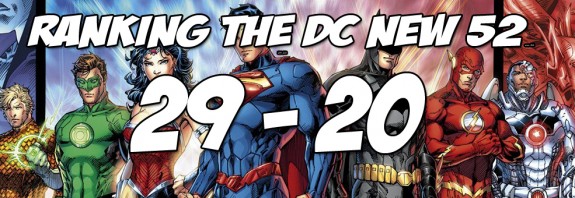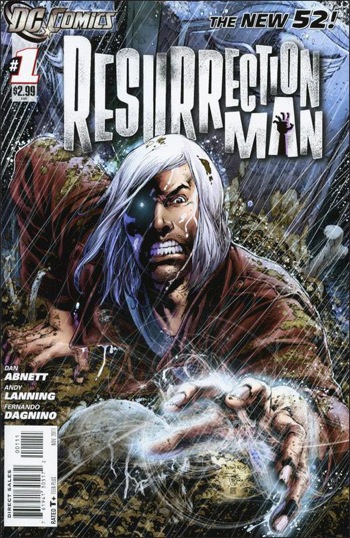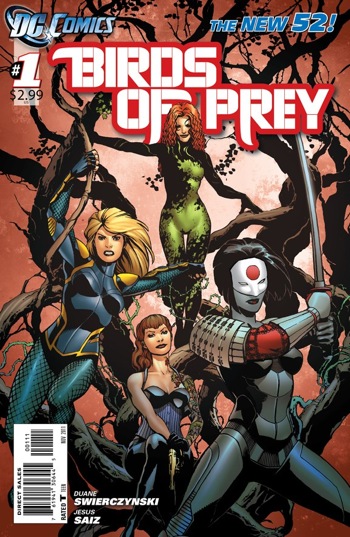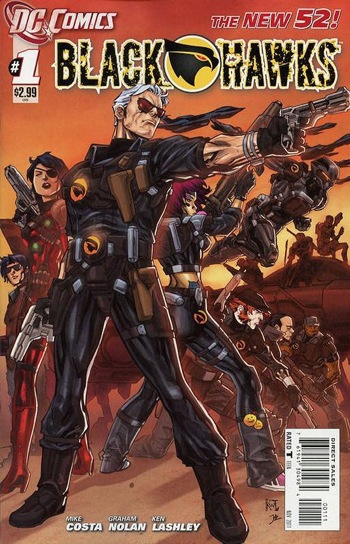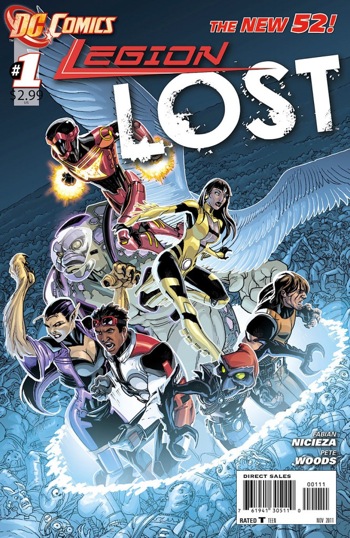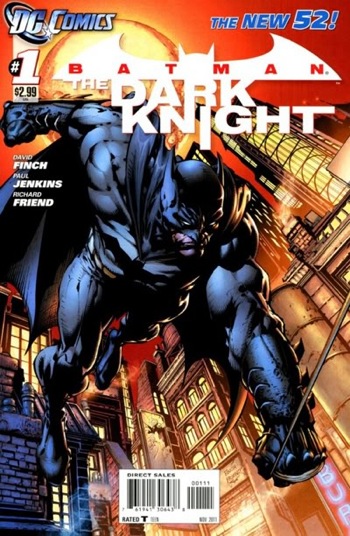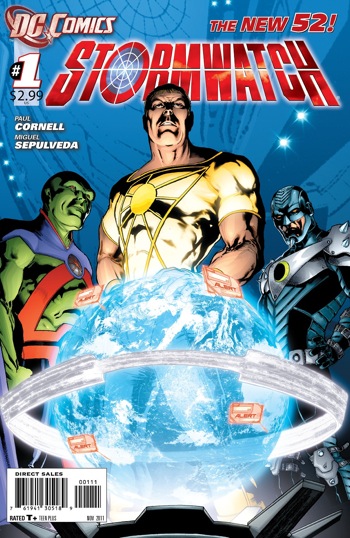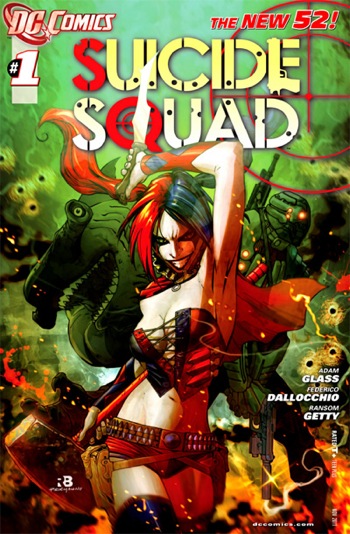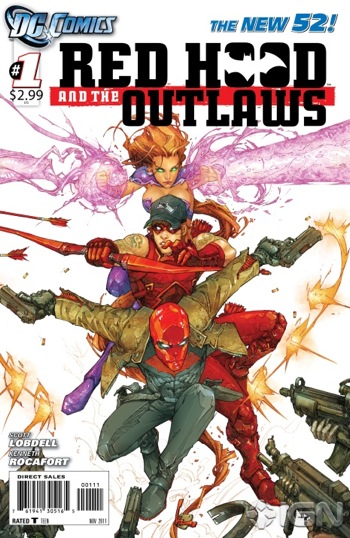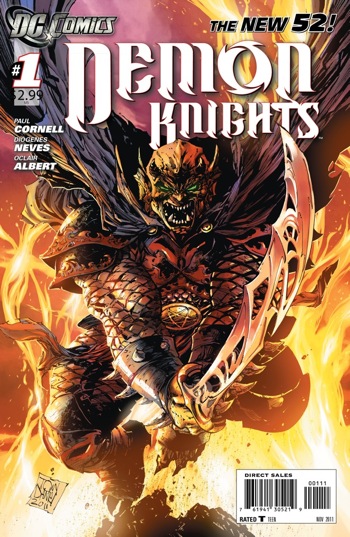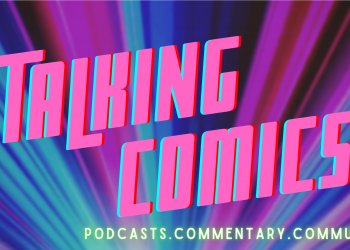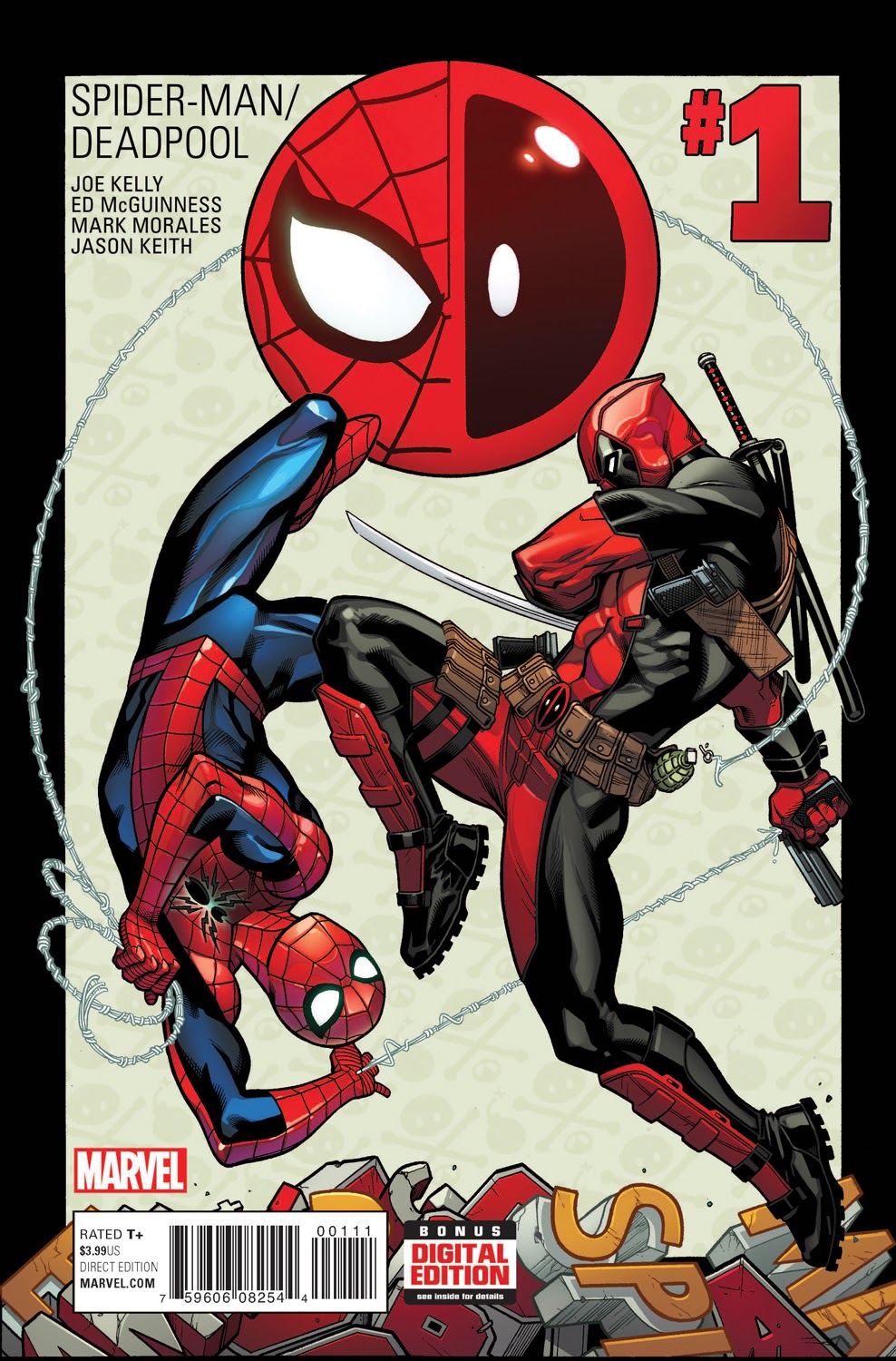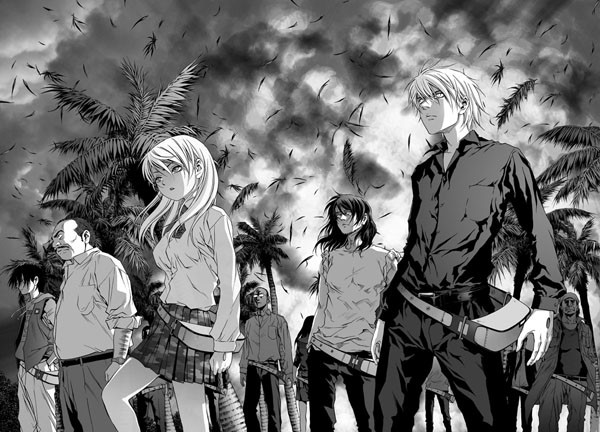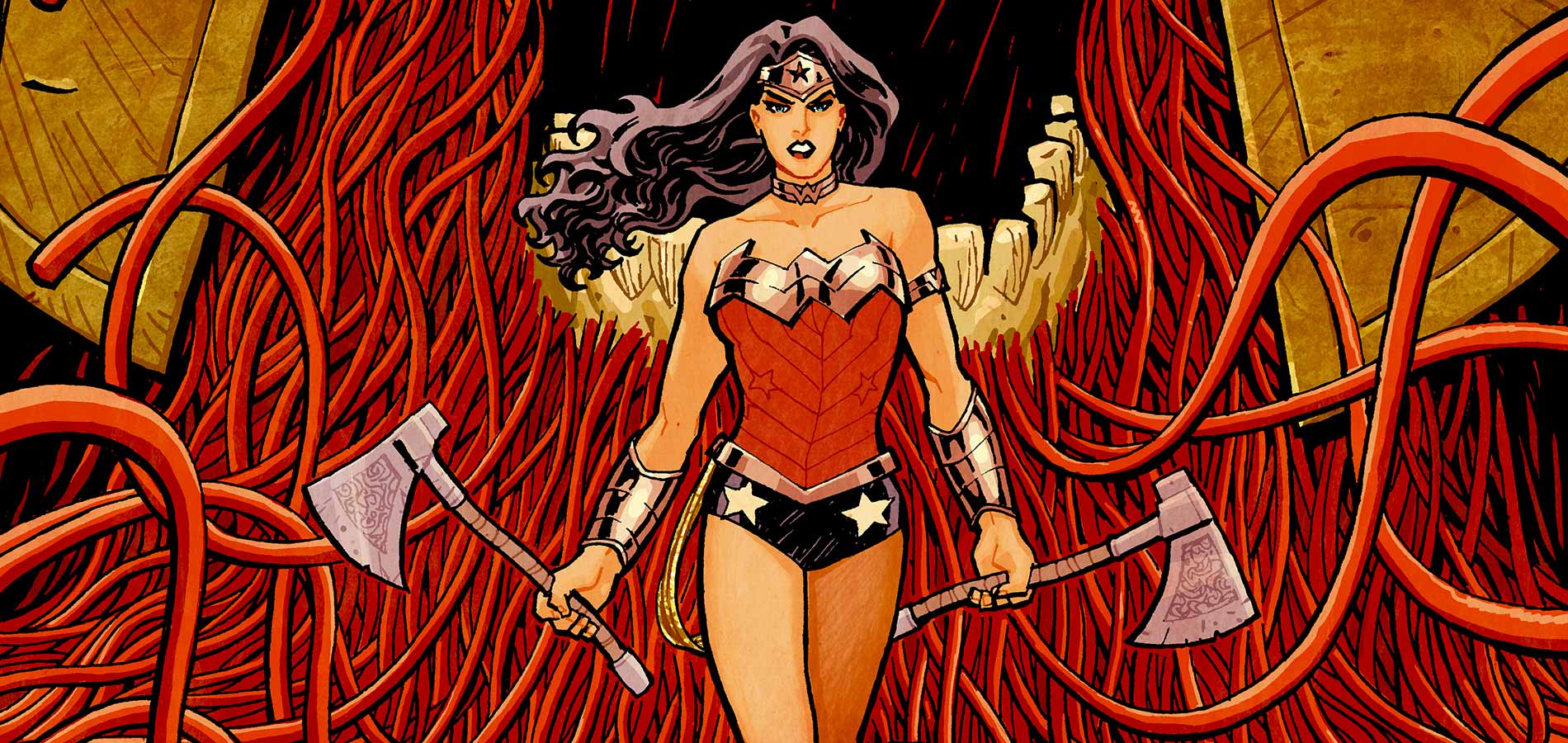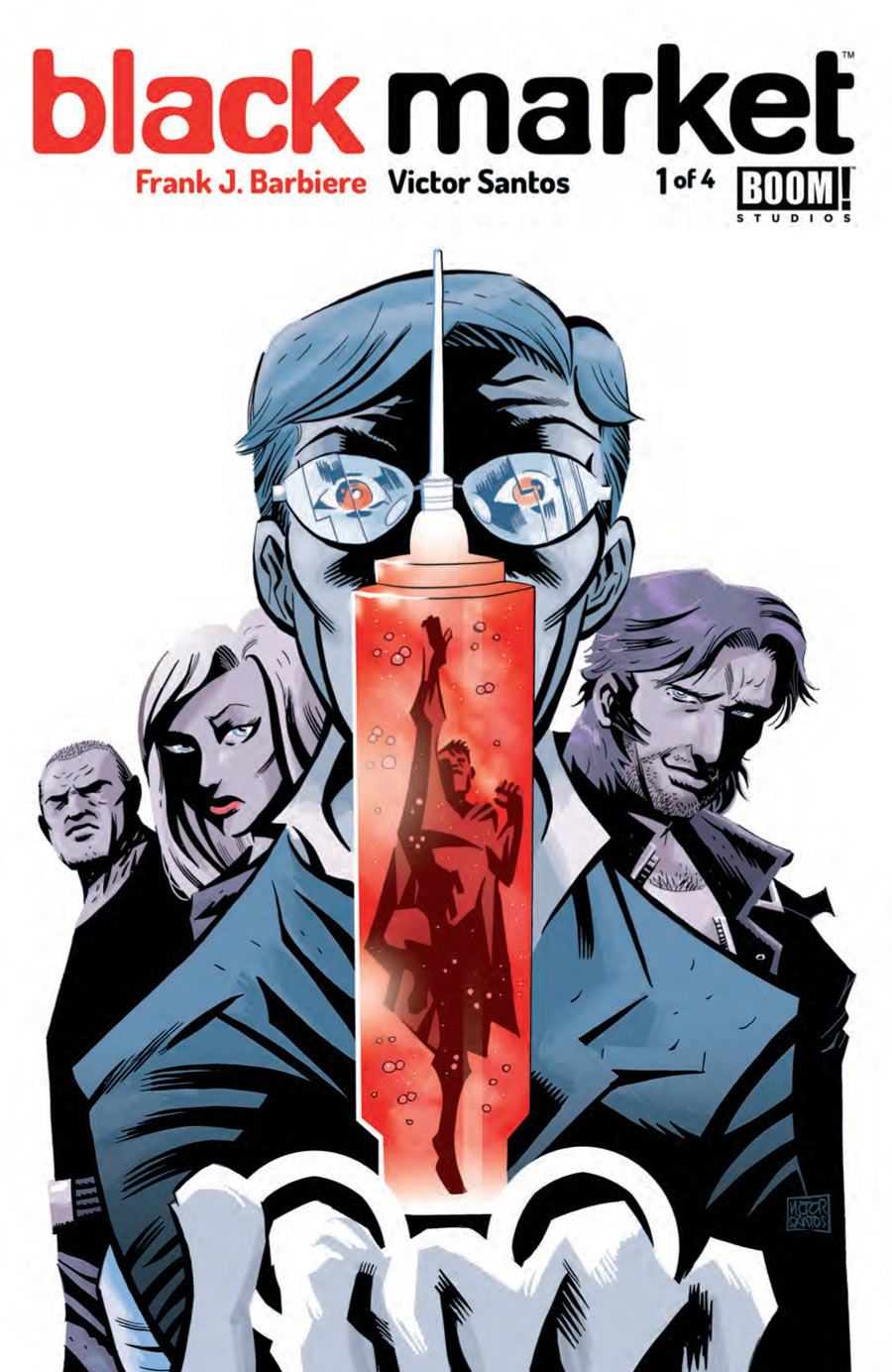By Bobby Shortle
Welcome to my ranking of the DC Comics New 52! I have spent the better part of the last month reading and re-reading all of the comics that debuted in this industry changing relaunch, and now over the next week or so I will be ranking them 52-1.
A couple of caveats, I have not read all twelve, or for some thirteen, issues of these series. Instead, I read as much as I could, until picking up the next issue seemed like the last thing I would ever want to do. For some that came at #3, for others #6 and for some it never came. If a book went under a creative change, I would always read at least one issue from that new creator in case things dramatically changed. I’m confident this allowed me to get a clear picture of the quality of the current runs and also helped me rank based on my gut feeling, rather than cold hard logic.
To give context to the article I have included excerpts from Talking Comics’ original reviews of these books and also sales numbers for the series in question.
If you missed it here is the link to the list featuring 52-40! If you missed it here is the link to the list featuring 39-30!
I welcome your reactions, disagreements and feedback which I hope you will leave in the comment section below. So, without further delay here is the Talking Comics DC New 52 Rankings:
29. Resurrection Man
The Verdict Then:
From Steve Seigh’s Review of Resurrection Man # 1
“Resurrection Man appears to have real potential. A concept with seemingly limitless possibilities the book does a great job of starting you off on the right foot. The overall tone is that of an “identity lost” scenario that screams of intrigue and had kept me interested throughout the entire read. Superb line work and brilliant color fills each page and gives you a plenty of bang for your buck.”
The Verdict Now:
There it is again, that most bittersweet of terms, potential. I absolutely love the premise of Resurrection Man. The idea of a superhero who changes his powers every time he dies is a concept with limitless possibilities, and so it’s a shame that Resurrection Man never delivers fully on its set up.
Dan Abnett and Andy Lanning are clever with their plotting, and they they inject their title with a bizarre sensibility that is lacking in a lot of the current DC universe. However, the book’s narrative meanders too slowly, the supporting cast is thin and I found the attempts to fill in the Resurrection Man’s backstory to be unsuccessful. Make no mistake this isn’t a bad book, but it also never crosses the line from okay to good.
Sales:
09/2011: Resurrection Man #1 — 41,740
10/2011: Resurrection Man #2 — 38,560 (- 7.6%)
11/2011: Resurrection Man #3 — 29,480 (-23.6%)
12/2011: Resurrection Man #4 — 23,060 (-21.8%)
01/2012: Resurrection Man #5 — 20,750 (-10.0%)
02/2012: Resurrection Man #6 — 18,569 (-10.5%)
03/2012: Resurrection Man #7 — 17,176 (- 7.5%)
04/2012: Resurrection Man #8 — 16,664 (- 3.0%)
05/2012: Resurrection Man #9 — 18,018 (+ 8.1%)
06/2012: Resurrection Man #10 — 15,481 (-14.1%)
07/2012: Resurrection Man #11 — 14,715 (- 5.0%)
28. Birds of Prey
The Verdict Then:
From Brian Verderosa’s Review of Birds of Prey #1
“As a big fan of the old-school Birds of Prey, I must say I was pleasantly surprised by how Swierczynski was able to give us a fair degree of fun, real-world stakes and a great introduction to the new team.”
The Verdict Now:
There isn’t a lot to say about Birds of Prey, except that its just…okay. Hey, that rhymed!
This series is a rare case of the finished product not equaling up to the sum of its parts. The characters are well developed, the plots fun enough, and there are even some cool twists, but there is also nothing special about any of these things. I think this book, much more so than Batgirl, is hurt by Barbara Gordon leaving her chair and putting back on the cowl as the inclusion of a character like Oracle would make the team standout. Instead, they are just one more group of heroes trying to make their way, and there are plenty of other team-ups I’d rather read.
Sales:
07/2011: Birds of Prey #14 — 27,102 (- 6.5%)
08/2011: Birds of Prey #15 — 26,043 (- 3.9%)
09/2011: Birds of Prey #1 — 56,073 (+115.3%) [66,423]
10/2011: Birds of Prey #2 — 53,156 (- 5.2%)
11/2011: Birds of Prey #3 — 40,891 (- 23.1%)
12/2011: Birds of Prey #4 — 34,460 (- 15.7%)
01/2012: Birds of Prey #5 — 31,700 (- 8.0%)
02/2012: Birds of Prey #6 — 30,376 (- 4.2%)
03/2012: Birds of Prey #7 — 29,196 (- 3.9%)
04/2012: Birds of Prey #8 — 28,661 (- 1.8%)
05/2012: Birds of Prey #9 — 41,521 (+ 44.9%)
06/2012: Birds of Prey #10 — 28,457 (- 31.5%)
07/2012: Birds of Prey #11 — 27,389 (- 3.8%)
27. Blackhawks
The Verdict Then:
From my review of Blackhawks #1
“The team dynamic here is fun and layered (in an action movie kind of way). But for all of that positive, I just can’t find it within myself to be excited for next month. It’s probably the fact that any below the surface character development is practically non existent.”
The Verdict Now:
Blackhawks turned into a fun and action packed read that gave just enough of a G.I. Joe twist on the standard military book to keep me engaged and entertained. In just the first three issues writer Mike Costa had created characters who had separate, distinct voices, which gave the team a personality the other war books sorely lacked. However, despite all of its good qualities, Blackhawks was an easy book for me to give up. It could never branch out from being something that was “fun” to read, to something that compelled me to buy it every month. If the series had gotten more time to develop it might have reached those heights, but as it stands we’ll simply never know.
Sales:
09/2011: Blackhawks #1 — 40,014
10/2011: Blackhawks #2 — 31,704 (-20.8%)
11/2011: Blackhawks #3 — 22,349 (-29.5%)
12/2011: Blackhawks #4 — 16,810 (-24.8%)
01/2012: Blackhawks #5 — 13,630 (-18.9%)
02/2012: Blackhawks #6 — 11,922 (-12.5%)
03/2012: Blackhawks #7 — 10,668 (-10.5%)
04/2012: Blackhawks #8 — 10,166 (- 4.7%)
26. Legion Lost
The Verdict Then:
From Brad Jones’ Review of Legion Lost #1
“I have an admission…I did not like Legion Lost. At all. It’s not that it’s poorly written or drawn; it’s because I just didn’t care and nothing in 22 pages was able to nudge me into any emotional connection to the material.”
The Verdict Now:
Legion Lost is an interesting bird. It shares a lot in common with its sister book Legion of Superheroes, in that it’s confusing, too full of characters and seems to give no mind to the entire idea of a rebooted universe. But, unlike LOS, Legion Lost immediately begins to craft a rather compelling tale of a group of people, adrift in a time, who are scrambling to right wrongs for the good of the future.
It has a strong sense of character and a story that has its tentacles in a lot of my favorite genres. Where it goes wrong is its reliance on a DCU history that technically doesn’t exist anymore, and its unfortunate intersection with the much weaker Teen Titans/Superboy ongoing storyline. I would say though, if you can find the trade cheap, give it a try.
Sales:
09/2011: Legion Lost #1 — 46,362
10/2011: Legion Lost #2 — 42,650 (- 8.0%)
11/2011: Legion Lost #3 — 31,226 (-26.8%)
12/2011: Legion Lost #4 — 24,020 (-23.1%)
01/2012: Legion Lost #5 — 21,549 (-10.3%)
02/2012: Legion Lost #6 — 19,447 (- 9.8%)
03/2012: Legion Lost #7 — 18,214 (- 6.3%)
04/2012: Legion Lost #8 — 17,984 (- 1.3%)
05/2012: Legion Lost #9 — 23,794 (+32.3%)
06/2012: Legion Lost #10 — 17,581 (-26.1%)
07/2012: Legion Lost #11 — 17,037 (- 3.1%)
25. Batman: The Dark Knight
The Verdict Then:
From Steve Seigh’s Review of Batman: The Dark Knight #1
“It pains me to say this, but with so many Batman books on the rise there may be other story arcs that make more sense than this one. If you’re a huge Batman fan, and I am, you’ll want to pick this up solely for dedication to the character, but you might not like what you find within it’s pages.”
The Verdict Now:
The first arc of Batman: The Dark Knight is all the things I don’t want in a Batman story. It features the same strange fascination with sex that Detective Comics had, it has a violent stupid story and it seems to be disgusting just for disgusting’ sake. So, why does a book this bad come in at #25?
It’s because Gregg Hurwitz took over the book with issue ten and completely transformed Batman:The Dark Knight from an ignorable and abject failure, into a tightly written, spooky and worthy addition to the library of Caped Crusader titles. The Hurwitz penned issues of this book would have easily ranked in the top 15, but the previous creative team was so bad, that it would have easily ranked as one of the worst books in the entire New 52. So, I split the difference and slotted it here. Start with issue 10 and you will not be disappointed.
Sales:
09/2011: Dark Knight #1 — 109,321 (+106.6%)
10/2011: Dark Knight #2 — 100,494 (- 8.1%)
11/2011: Dark Knight #3 — 87,133 (- 13.3%)
12/2011: Dark Knight #4 — 78,689 (- 9.7%)
01/2012: Dark Knight #5 — 76,824 (- 2.4%)
02/2012: Dark Knight #6 — 77,140 (+ 0.4%) [
03/2012: Dark Knight #7 — 75,297 (- 2.4%)
04/2012: Dark Knight #8 — 74,287 (- 1.3%)
05/2012: Dark Knight #9 — 82,169 (+ 10.6%)
06/2012: Dark Knight #10 — 71,671 (- 12.8%)
07/2012: Dark Knight #11 — 68,632 (- 4.2%)
24. Stormwatch
The Verdict Then:
From Steve Seigh’s Review of Stormwatch #3
“Stormwatch #3 hit the mark for me. If you’ve found yourself lost, or perhaps not grooving on the tremendous cast of characters, this book orients itself in such a way that it’s much less confusing to follow along with each side plot. The art of Miguel Sepulveda is simply gorgeous. From the start of this series I have always enjoyed at least this aspect of the book itself. The depictions of the cosmos and atmospheric battles are really something worth checking out.“
The Verdict Now:
I found myself very charmed by Paul Cornell’s crazy, Torchwoodian team book. There is a refreshing look at some lesser known characters and the series has an arch sense of fun that falls very much in line with the writer’s other New 52 series, Demon Knights. It’s this unique sensibility and positively stunning art that makes this title something worth looking into. Also worth noting is the ignored homosexual relationship between Apollo and The Midnighter, which develops naturally and organically. It’s a shame the poorly handled Alan Scott story line got all the press when what is in these pages is leaps and bounds better.
Sales:
09/2011: Stormwatch #1 — 46,397
10/2011: Stormwatch #2 — 47,520 (+ 2.4%)
11/2011: Stormwatch #3 — 39,262 (-17.4%)
12/2011: Stormwatch #4 — 30,987 (-21.1%)
01/2012: Stormwatch #5 — 29,112 (- 6.1%)
02/2012: Stormwatch #6 — 26,076 (-10.4%)
03/2012: Stormwatch #7 — 24,384 (- 6.5%)
04/2012: Stormwatch #8 — 23,212 (- 4.8%)
05/2012: Stormwatch #9 — 22,448 (- 3.3%)
06/2012: Stormwatch #10 — 20,592 (- 8.3%)
07/2012: Stormwatch #11 — 19,678 (- 4.4%)
23. Suicide Squad
The Verdict Then:
From Brian Verderosa’s Review of Suicide Squad #1
“Suicide Squad is back, and Glass has given it a much darker edge, but it absolutely works. The current Squad lineup (Deadshot, Harley Quinn, El Diablo, King Shark, Black Spider, Voltaic and Savant) is eclectic and diverse, however the dangerous vibe is paramount throughout.”
The Verdict Now:
I find myself wanting to apologize for the fact that I really dig Adam Glass’ Suicide Squad. It’s grimy, hyper violent and at times exceedingly cruel, but to me it’s just the right mix of those elements to keep me coming back. I don’t generally like villain books, but a book about a bunch of villains trying to be heroes, just does it for me.
My main qualm with the book comes from its bizarre handling of Harley Quinn, who apparently DC has decided to make more sexual than she ever has been before. I don’t have an issue with bringing new shades to the character, but this seems like a play at the lowest common denominator and that will always knock a book down a few pegs. However, if you can see past this bizarre choice, and you like some of your books a little on the bloody side, then Suicide Squad is something you should check out.
Sales:
09/2011: Suicide Squad #1 — 49,979
10/2011: Suicide Squad #2 — 49,570 (- 0.8%)
11/2011: Suicide Squad #3 — 40,827 (-17.6%)
12/2011: Suicide Squad #4 — 34,550 (-15.4%)
01/2012: Suicide Squad #5 — 32,726 (- 5.3%)
02/2012: Suicide Squad #6 — 30,834 (- 5.8%)
03/2012: Suicide Squad #7 — 32,908 (+ 6.7%)
04/2012: Suicide Squad #8 — 32,789 (- 0.4%)
05/2012: Suicide Squad #9 — 32,581 (- 0.6%)
06/2012: Suicide Squad #10 — 31,576 (- 3.1%)
07/2012: Suicide Squad #11 — 29,809 (- 5.6%)
22. Red Hood and the Outlaws
The Verdict Then:
From Brad Jones’ Review of Red Hood and the Outlaws #1
“This book is confectionary sugar with a core of horseshit…Avoid at all costs – this book will give you a headache in banality”
The Verdict Now:
Red Hood and the Outlaws is a slow starter, in fact the first few issues are downright bad. But around the time you hit the fourth installment the book turns into something I never would have imagined, it becomes worthwhile. Scott Lobdell’s story of this rag tag team doesn’t deserve to be mentioned with the best of the best, but it is a solid misfit story with a unique team dynamic.
Jason Todd raises above just being a whiney ex-Robin, to be a true badass who, much like Kane Parker in Scarlet Spider, finds himself overcoming his past to become a real hero. However, the real pull of the book for me is the oddball, yet tender, relationship between Roy Harper and Starfire. A lot has been made of the book’s treatment of Princess Koriand’r, and the criticism is fair and deserved. She starts out the book as a promiscuous, scantily dressed, and suggestively posed pin up, but as the story goes along Lobdell brings depth and shades to her that I didn’t expect.
Red Hood and the Outlaws is at times too exploitive, too violent and too on the nose, but the good outweighs the bad and if you are looking for something with a little bit of an edge you won’t be disappointed.
Sales:
09/2011: Red Hood #1 — 56,112
10/2011: Red Hood #2 — 59,382 (+ 5.8%)
11/2011: Red Hood #3 — 50,140 (-15.6%)
12/2011: Red Hood #4 — 44,278 (-11.7%)
01/2012: Red Hood #5 — 42,560 (- 3.9%)
02/2012: Red Hood #6 — 39,898 (- 6.3%)
03/2012: Red Hood #7 — 38,630 (- 3.2%)
04/2012: Red Hood #8 — 37,974 (- 1.7%)
05/2012: Red Hood #9 — 54,220 (+42.8%)
06/2012: Red Hood #10 — 37,044 (-31.7%)
07/2012: Red Hood #11 — 35,820 (- 3.3%)
21. Green Lantern: New Guardians
The Verdict Then:
From My Review of Green Lantern: New Guardians #1
“Green Lantern: New Guardians is engaging, funny, and entertaining. The “what have I gotten myself into” tone harkens back to great 80′s/90′s action films and video games in the Uncharted series.”
The Verdict Now:
I can admit one thing right off the bat, I was completely wrong about the tenor and tone of Green Lantern: New Guardians. What I perceived as some sort of 80’s/90’s action flick feel in the first issue, soon gave way to a more traditional Green Lantern story. I will also freely admit to being constantly entertained by this tale of ringslinger Kyle Rainer and his merry band of misfit lanterns.
New Guardians lacks the subtlety of Geoff John’s book and the comradery of Tomasi’s Green Lantern Corp, but it makes up for it with a crazy galactic plot, over the top characters and clever exploration of the many colors of the emotional spectrum. This book isn’t great, but it’s solid and to top it off it’s downright fun. My only complaint is that its story takes too damn long to get going, and so it works much better in a collected volume than in single issues. However, if you are a Green Lantern nut, it’s a title that you should be reading.
Sales:
09/2011: New Guardians #1 — 84,033 (+90.0%) [96,596]
10/2011: New Guardians #2 — 71,713 (-14.7%)
11/2011: New Guardians #3 — 59,774 (-16.7%)
12/2011: New Guardians #4 — 53,305 (-10.8%)
01/2012: New Guardians #5 — 52,305 (- 1.9%)
02/2012: New Guardians #6 — 50,319 (- 3.8%)
03/2012: New Guardians #7 — 48,422 (- 3.8%)
04/2012: New Guardians #8 — 47,320 (- 2.3%)
05/2012: New Guardians #9 — 46,237 (- 2.3%)
06/2012: New Guardians #10 — 44,404 (- 4.0%)
07/2012: New Guardians #11 — 42,929 (- 3.3%)
20. Demon Knights
The Verdict Then:
From my review of Demon Knights #1
“Sometimes the hardest books to write about are the ones you just flat love. Demon Knights is one such book. I’m enamored with the setting and characters as much as I am the pencils by Diogenes Neves and I dig the idea of the Questing Queen, our big bad, and the merciless baby killing trek of blood she is on. But what I love most is the largess of the world created by Paul Cornell.”
The Verdict Now:
I did really love Demon Knights and yet, as the titles on my pull list begin to grow in number, it still managed to be one of the first causalities of the ever present “money crunch.” Paul Cornell’s book has a stupendous sense of character, a great villain and I absolutely adore its fantasy setting . Unfortunately, Demon Knights is another line in a song that has become all too common in this section of my list. In that, it’s a strong book, with clever story telling, but it takes much too long to get where it’s going. If the story pacing was better it would sit much higher on this list, but the lack of forward momentum clouds and obscures the great things this title has to offer. I would never tell anyone not to read this book, but it would not be on the tip of my tongue when it came to a recommendation.
Sales:
09/2011: Demon Knights #1 — 41,602
10/2011: Demon Knights #2 — 42,230 (+ 1.5%)
11/2011: Demon Knights #3 — 34,681 (-17.9%)
12/2011: Demon Knights #4 — 28,109 (-19.0%)
01/2012: Demon Knights #5 — 25,823 (- 8.1%)
02/2012: Demon Knights #6 — 23,476 (- 9.1%)
03/2012: Demon Knights #7 — 22,000 (- 6.3%)
04/2012: Demon Knights #8 — 21,124 (- 4.0%)
05/2012: Demon Knights #9 — 20,196 (- 4.4%)
06/2012: Demon Knights #10 — 19,005 (- 5.9%)
07/2012: Demon Knights #11 — 18,201 (- 4.2%)


